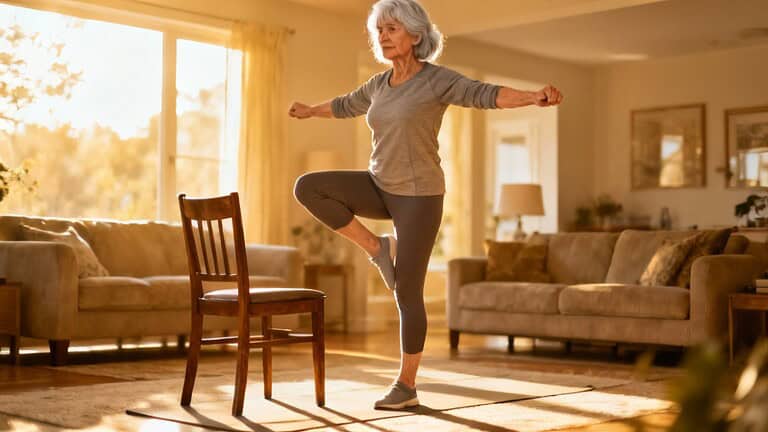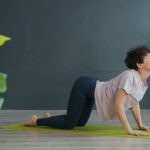What if your ability to stay on your feet, walk confidently, and live independently had nothing to do with your age? Groundbreaking research has flipped the script on what we thought we knew about falling after 60.
The real reason isn’t just weak legs or getting older—it’s that we stop challenging our balance and moving in ways that keep us strong, stable, and sharp.
This article isn’t just about preventing falls; it’s about reclaiming your power. Because the truth is, balance isn’t something you lose forever. It’s a skill that can be trained, improved, and mastered at any age, but only if you’re doing the right kind of movement.
1. Side Stepping: The Forgotten Lifesaver
If you ever lose your balance, your first instinct is to take a quick step to the side to catch yourself. But what if your body has forgotten how to do that? That’s exactly why side stepping is one of the most powerful and most overlooked movements for fall prevention.
Most people over 60 never practice lateral movement. We walk forward, maybe backward, but we almost never move side to side. The problem is that falls rarely happen in straight lines.
A sudden nudge in the grocery store, stepping off a curb, or losing balance in the bathroom—these moments demand a quick protective side step.
If your muscles and brain haven’t practiced it, your body freezes. That’s when falls happen. Practicing side stepping does more than wake up unused muscles; it retrains your brain to respond, not panic.
How to do it:
- Stand next to a sturdy chair or countertop
- Take a big step to the side, then bring your other foot in
- Repeat in the other direction
- Try not to shuffle; lift your feet
- Keep your knees slightly bent and posture upright
- Start slow and hold on if needed
- Aim for one to two minutes daily
2. Weight Shifting: Reclaim the Rhythm of Walking
You take over 5,000 steps a day, but how many of those steps are truly balanced? One of the most common early signs of declining mobility isn’t falling; it’s shuffling—that slow, uncertain drag of the feet. It happens when your brain loses confidence in your ability to shift weight from one leg to the other.
Weight shifting is the foundation of walking. It’s how we transfer energy, move forward, and stay stable. This simple movement reawakens your body’s natural gait and restores the brain-body connection that says, “I trust my legs again.”
How to do it:
- Stand behind a sturdy chair
- Place both hands lightly on the backrest
- Shift your full weight onto your right leg while lifting your left foot just an inch off the ground
- Hold for 3 to 5 seconds, then switch sides
- Focus on fully committing your weight
- Over time, try letting go with one hand, then no hands
3. Single Leg Stand: The Number One Balance Predictor
After 60, if you can’t stand on one leg for at least 10 seconds, research shows your risk of falling or even serious injury multiplies. But here’s the encouraging truth: this isn’t a test of youth. It’s a trainable skill, and it’s arguably the single most powerful indicator of functional balance in older adults.
Life constantly challenges your balance on one leg—stepping into a car, putting on pants, climbing stairs, avoiding obstacles. Every one of these tasks depends on your ability to stabilize on one side while the other leg moves.
How to do it:
- Stand near a counter or sturdy chair
- Shift your weight fully onto your right leg
- Slowly lift your left foot an inch or two off the ground
- Try holding for 10 to 20 seconds
- Use your hands at first if needed
- Switch sides and do two to three rounds daily
- As stability improves, try closing your eyes
4. Heel to Toe Walk: Reprogram Your Walk, Reclaim Your World
As we age, our walking pattern often widens—feet farther apart, steps shorter, posture less stable. While it feels safer, it’s actually the opposite. A wide stance reduces balance feedback and reaction speed, especially on uneven ground or in tight spaces.
The heel-to-toe walk is a powerful way to retrain your gait and improve what’s called your base of support—the way your body senses balance in motion. It sharpens coordination, strengthens the feet and ankles, and rebuilds your ability to move with purpose instead of hesitation.
How to do it:
- Stand near a wall or counter
- Take a step forward, placing your heel directly in front of your toe
- Repeat with the other foot, keeping your steps slow and controlled
- Use support if needed
- Aim for four to six steps at a time
- Focus on posture—tall spine and eyes forward
5. Pillow Squats: Power, Stability, and the Confidence to Rise
If you’ve ever struggled to get up from a soft couch or low chair, this movement is for you. Pillow squats are more than just a leg exercise; they train your body for one of the most essential and overlooked functions of independence—the ability to rise.
Standing up from a seated position engages your quadriceps, hamstrings, glutes, core, and even your heart. When standing becomes hard, we stop doing it.
But when we stop doing it, it becomes even harder. This creates a dangerous cycle that leads to overdependence on walkers or assistance.
How to do it:
- Place one or two cushions on a chair
- Sit down with arms crossed or lightly support on thighs if needed
- Lean slightly forward and push through your heels to stand up tall
- Then sit back down slowly
- Repeat five to 10 times
- Progress by reducing hand assistance and removing pillows as strength improves
6. Backward Stepping: Rediscover the Movement That Keeps You Safe
When was the last time you intentionally stepped backward? Most people can’t remember, and yet we do it all the time—stepping away from a cabinet, moving back from the sink, adjusting in a tight hallway. But here’s the catch: if you never train this movement, your body slowly forgets how to do it safely.
Backward stepping requires greater control, coordination, and spatial awareness than forward walking. It challenges your body’s balance system, strengthens key stabilizer muscles, and trains your brain to stay calm and responsive in unexpected situations.
How to do it:
- Stand facing a chair or counter
- Step one foot back, then the other for two to three steps
- Turn around and repeat in the opposite direction
- Lift your feet—no dragging
- Keep your knees slightly bent, posture upright
- Use light support if needed
- Just one to two minutes daily can dramatically improve how you move and react
Your Journey to Better Balance Starts Now
Balance isn’t lost with age; it’s rebuilt with intention. Each of these six exercises isn’t about working out; they’re about training your body for life—for reaching, turning, stepping, rising, recovering; for staying steady on the stairs; for walking into a room without fear.
Here’s what most people don’t realize: it doesn’t take hours a day or a gym. Just 10 to 15 minutes of intentional movement done regularly can rebuild strength, coordination, and confidence. And the more consistently you do these, the more they become your new normal.
Your body is not too old, your balance is not gone, and you are not stuck. With the right movements at any age, you can move forward stronger, steadier, and more free than ever.








